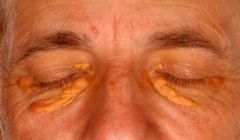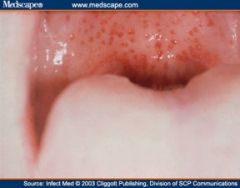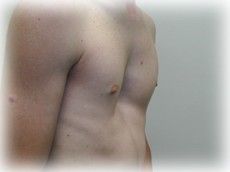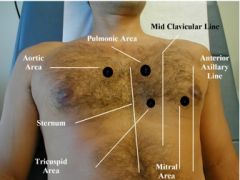![]()
![]()
![]()
Use LEFT and RIGHT arrow keys to navigate between flashcards;
Use UP and DOWN arrow keys to flip the card;
H to show hint;
A reads text to speech;
40 Cards in this Set
- Front
- Back
- 3rd side (hint)
|
What symptoms would prompt a heart exam?
|
-chest pain
-palpitations -dyspnea -syncope -fatique -dependent edema -hemoptysis -cyanosis |
|
|
|
Besides heart disease which disorders can generate chest pain?
|
-pulmonary disorders
-intestinal disorders -gallbladder -musculoskeletal/Neuro disorders -skin disorders |
|
|
|
What are palpitations described as?
|
"Fluttering, skipped beats, pounding, jumping, stopping, or irregularity"
|
|
|
|
What can induce palpitations?
|
-thyrotoxicosis
-hypoglycemia -fever -anemia -anxiety -caffeine -tobacco -other drugs |
|
|
|
What is dyspnea?
|
Shortness of Breath (SOB)
-related to cardiac or pulmonary conditions |
|
|
|
What are kinds of Dyspnea are there?
|
-PND (paroxysmal nocturnal dyspnea_
-Orthopnea (# of pillows needed) -DOE (Dyspnea on exertion) -Trepopnea (positional dyspnea while lying on left/right side -rare) |
|
|
|
Syncope is:
|
Transient loss of consciousness due to inadequate cerebral perfusion
|
|
|
|
Causes of syncope
|
-Cardiac vs. non-cardiac causes
-Orthostatic hypotension -Vasovagal syncope -Carotid sinus syncope |
|
|
|
Fatique is:
|
-Common symptom of decreased cardiac output
-Not specific for cardiac disease -Most common causes: anxiety/depression -Other causes: anemai & chronic diseases |
|
|
|
Dependent Edema is:
|
Swelling of the legs/lower extremities
|
|
|
|
What is dependent edema the result of ?
|
Congestive Heart Failure (CHF)
|
|
|
|
_____ _____ worsens as day progresses
|
Symmetrical Edema
|
|
|
|
_____ precedes edema
|
Dyspnea
|
|
|
|
What kind of edema do bedridden patients commonly have
|
sacral edema
|
|
|
|
This is most commonly due to mitral stenosis
|
Hemoptysis
|
|
|
|
More commonly caused by pulmonary causes & resulting in the rupture of the bronchial veins due to high back pressure in mitral stenosis this condition is _____
|
Hemoptysis
|
|
|
|
Where is cyanosis most commonly seen?
|
Finger nail beds
|
|
|
|
What is lower extremity cyanosis is termed as _____
|
Differential cyanosis
|
|
|
|
_____ Cyanosis is related to Left shunt through PDA (patent ductus arteriosus)
|
Differential
|
|
|
|
True/False Cyanosis is exclusive to cardiac conditions.
|
False. Cyanosis is also observed in pulmonary disorders.
|
|
|
|
Xanthomata
|
hypercholesterolema
|
|
|
|
-xanthomata
-hypercholestrelemia |

These are _____
associated with ____ |
|
|

These are _____
Associated with _____ |

-Xanthelasma - yellow plaques
-Hyperlipoproteinemia |
|
|
|
When inspecting the Facies you observe that your patient has wide set eyes, what kinds of dzs, do you suspect?
|
Congenital Heart Disease, especially pulmonic stenosis & supraventricular aortic stenosis.
|
|
|
|
Your patient has moon facies, you suspect?
|
pulmonary stenosis
|
|
|
|
A 53 y.o. black male patient has ear lobe creases what do you include in your differential diagnosis
|
CHF
|
|
|
|
Why do you inspect the facies in heart examinations?
|
Because heart abnormalities may be associated with peculiarities of the face & head.
|
|
|
|
While observing the fingernails of your patients' you observe splinter hemorrhages, what can they be associated with?
|
Infective endocarditis.
|
|
|
|
Infective Endocarditis
|

Petechia on Palate =
|
|
|
|
Congential Mitral Valve Prolapse
|

High arched palate =
|
|
|

You see this chest configuration...this is ___ & ___ valvular issue
|

-Marfan's Syndrome
-Mitral Valve Prolapse Result of chest & heart developing at same time during embryogenesis |
|
|
|
What areas do you auscultate on the heart
|

Aortic
Pulomonic Tricuspid Mitral |
Always Pay The Man
APT M |
|
|
What is the sounds is the diagphragm most useful for picking up?
|
High-pitched sounds
i.e. S1, S2, aortic or mitral regurgitation, pericardial friction rubs. |
|
|
|
What sounds is the bell most useful for picking up?
|
Low-pitched sounds
e.g. S3, S4, mitral stenosis |
|
|
|
How do you use the bell?
|
Press it gently against the skin.
Applying more pressure stretches the skin taut & results in the bell functioning like the diaphragm. |
|
|
|
What is S3 most commonly associated with?
|
Left ventricular failure & is caused by blood from the left atrium.
|
|
|
|
What causes the S3 sound?
|
Blood from the left atrium slamming into an already overfilled ventricle during early diastolic filling.
|
|
|
|
How is S4 sound created?
|
The S4 is sound created by blood trying to enter a stiff, non-compliant left ventricle during atrial contraction.
|
|
|
|
What is S4 heart sound associated with?
|
It is most frequently associated with left ventricular hypertrophy that is the result of long standing hypertension.
|
|
|
|
What is the presence of both S3 & S4 simultaneously referred to as?
|
A summation gallop.
|
|

